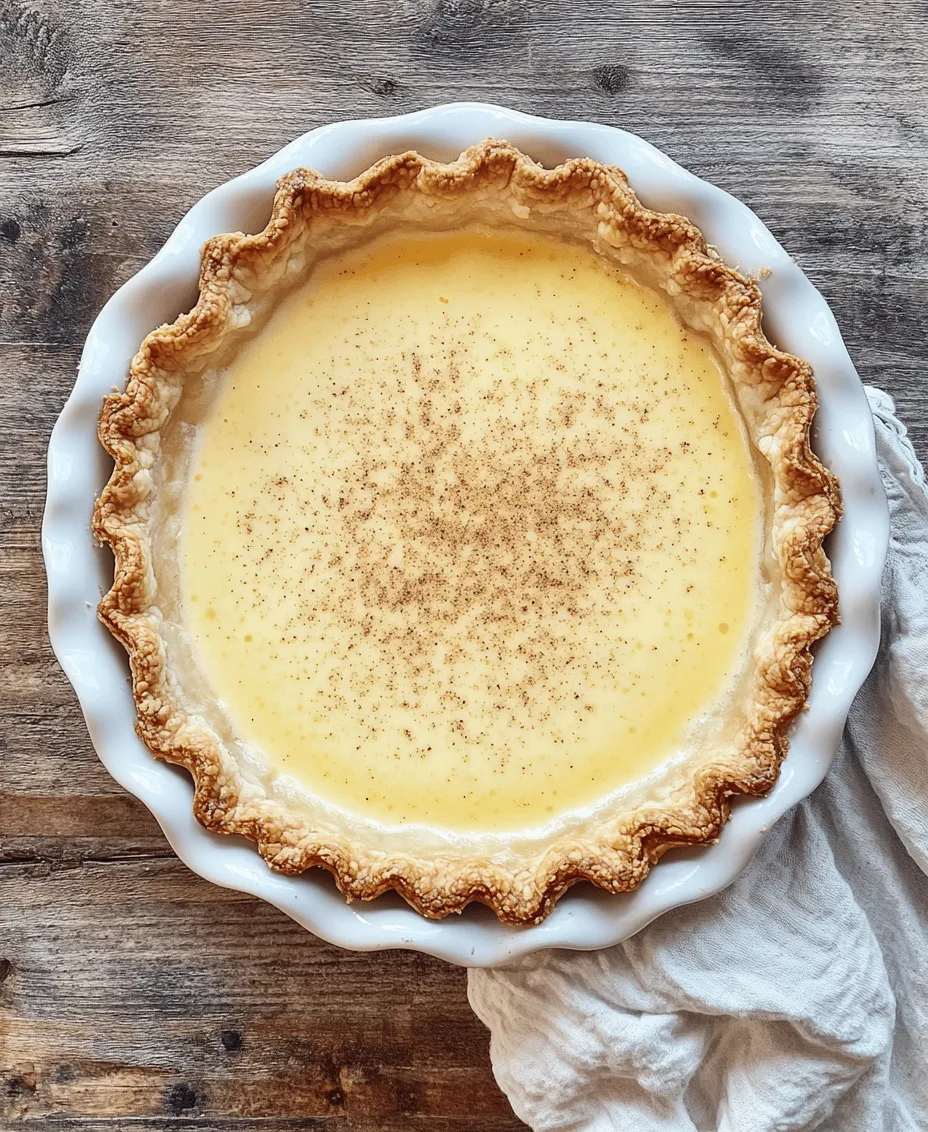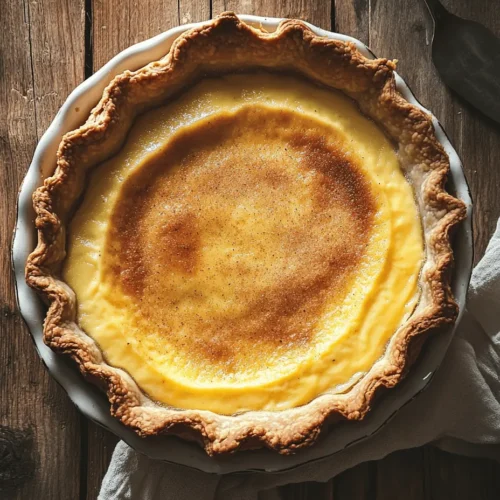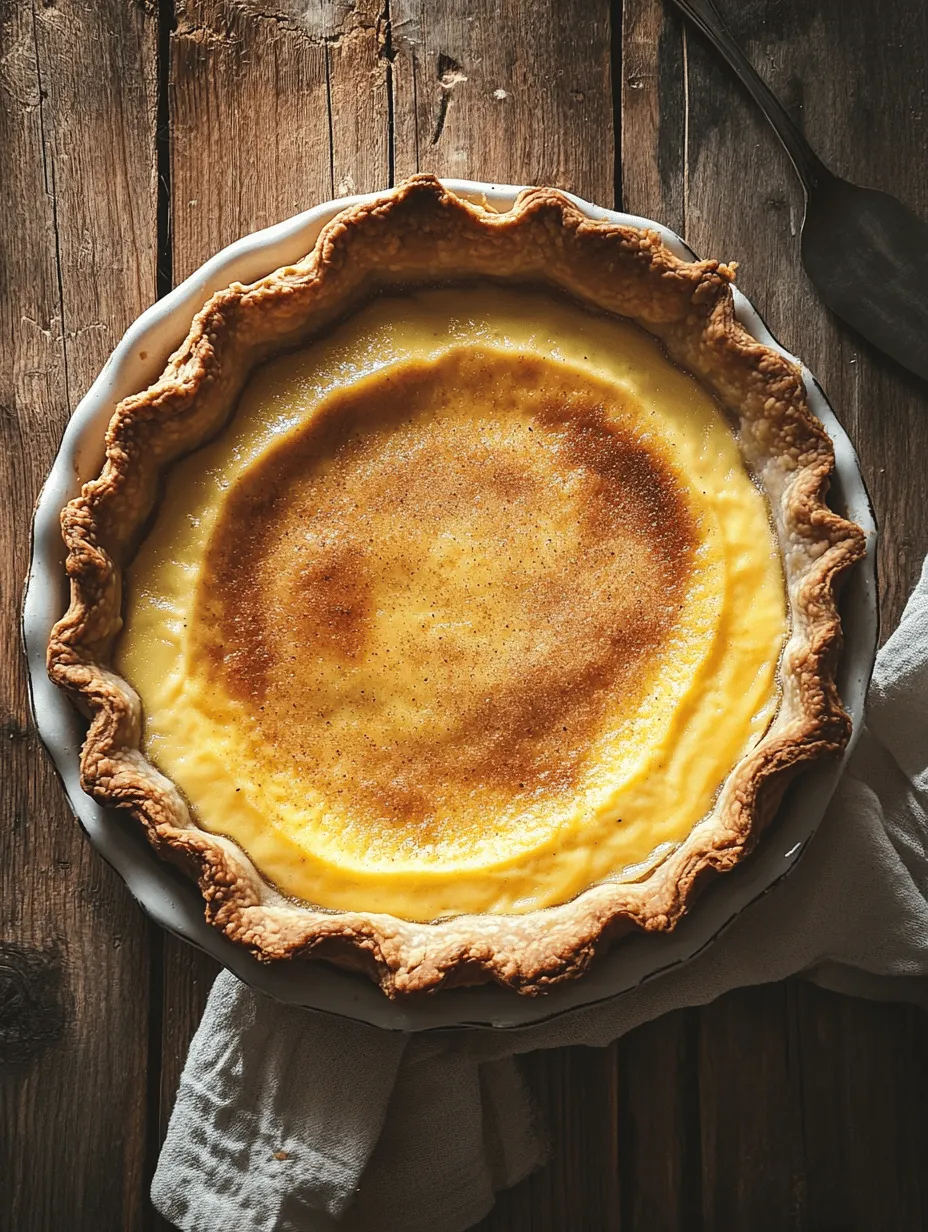Introduction
Egg custard pie stands as a beloved staple in American dessert culture, transcending generations with its creamy texture and comforting flavor. This classic dessert, often associated with family gatherings and holiday feasts, captures the essence of homemade goodness. The allure of egg custard pie lies not only in its simplicity but also in its ability to evoke nostalgia, reminding us of warm kitchens filled with the sweet aroma of baked custard.
Historically, the egg custard pie has roots that trace back to colonial America, drawing inspiration from European custard recipes. It became popular in the 19th century as a way to use abundant farm-fresh eggs and milk, making it a quintessential dish in rural households. Over time, this pie has solidified its place in American cuisine, delighting palates at Sunday dinners and festive celebrations alike.
The flavor profile of a classic egg custard pie is a harmonious blend of sweet creaminess, with a subtle hint of vanilla and a touch of spice from nutmeg or cinnamon. Its velvety texture is achieved through the careful balance of eggs and milk, creating a custard that is both rich and light. The key to a successful egg custard pie lies in the quality of its ingredients; using fresh, high-quality eggs and dairy will elevate the overall taste and texture of the final product, ensuring each slice is a delightful experience.
Understanding the Ingredients
To create the perfect egg custard pie, understanding the role of each ingredient is crucial. Here’s a breakdown of the essential components that come together to form this delicious dessert:
– Eggs: The backbone of any custard, eggs are critical for setting the filling. Their proteins coagulate during baking, giving the custard its firm yet creamy structure. Fresh eggs not only enhance flavor but also contribute to the pie’s rich yellow color.
– Granulated Sugar: This ingredient provides the necessary sweetness to balance the custard’s richness. The amount of sugar can be adjusted according to personal preference, but it is essential to achieve that delightful contrast to the creamy filling.
– Salt: A pinch of salt plays an important role in enhancing the flavors of the custard. It acts to elevate the sweetness and deepen the overall taste profile, making every bite more satisfying.
– Vanilla Extract: Vanilla is what brings warmth and depth to the egg custard pie. The aromatic essence of vanilla enhances the custard, making it more complex and inviting with every forkful.
– Whole Milk: A key ingredient that contributes to the pie’s creamy texture, whole milk is preferred for its richness. It creates the necessary base for the custard, ensuring it is smooth and indulgent.
– Unsalted Butter: Adding melted unsalted butter to the mixture not only enriches the flavor but also contributes to the custard’s luxurious mouthfeel. It helps to create a velvety texture that is characteristic of a well-made custard pie.
– Pre-made Pie Crust: For those seeking convenience, a pre-made pie crust saves time without sacrificing quality. It provides a flaky, buttery base that complements the smooth custard filling, allowing you to focus on perfecting the custard itself.
– Nutmeg or Cinnamon: These spices serve as flavor enhancers, adding warmth and a hint of spice to the custard. Nutmeg is traditionally used in egg custard pie, but cinnamon can also be included for those who enjoy a different twist. A light dusting of either spice just before baking also enhances the visual appeal of the pie.
Preparation Steps for Egg Custard Pie
Creating a classic egg custard pie requires precision and attention to detail. Following each step accurately will yield the best results, ensuring a smooth custard and a perfectly baked pie. Here’s a step-by-step breakdown of the preparation process:
1. Preheating the Oven: Begin by preheating your oven to 350°F (175°C). This ensures that the pie cooks evenly and thoroughly from the moment it is placed inside. A properly preheated oven is essential for achieving the desired custard consistency.
2. Beating the Eggs: In a mixing bowl, crack the eggs and beat them gently with a whisk or electric mixer. The goal is to achieve a uniform mixture without over-beating, which can incorporate too much air and result in an undesirable texture. Aim for a frothy consistency where the yolks and whites are completely combined.
3. Mixing the Ingredients: Gradually add the granulated sugar, salt, and vanilla extract to the beaten eggs. Mix thoroughly until the sugar is dissolved. Next, slowly pour in the whole milk and melted unsalted butter, stirring continuously to create a smooth custard mixture. The key here is to combine without creating bubbles, which could affect the pie’s final texture.
4. Pouring into the Pie Crust: Once the custard mixture is well combined, carefully pour it into the prepared pie crust. To ensure an even distribution, use a ladle or measuring cup, pouring slowly and steadily. This step is crucial, as it minimizes the risk of creating air pockets in the custard.
5. Sprinkling Nutmeg or Cinnamon: Finally, take a moment to sprinkle a light dusting of nutmeg or cinnamon over the top of the custard. This not only enhances the flavor but also adds an inviting aroma and visual appeal to the pie as it bakes.
With these initial steps completed, your egg custard pie is now ready to be baked, setting the stage for a delightful dessert that is sure to impress family and friends. As the pie bakes, the sweet scent of custard fills the kitchen, creating an anticipation that makes the wait well worth it. Stay tuned for the next part, where we will delve into the baking process and tips for ensuring your egg custard pie turns out perfectly every time.

Baking Process and Temperature
To successfully bake a classic egg custard pie, it is crucial to understand the baking process and the optimal temperature settings. Begin your baking by preheating your oven to 350°F (175°C). This moderate temperature allows the custard to cook evenly without curdling.
Once your pie shell is prepared and the custard mixture is combined, pour the filling into the pie crust. Carefully place the pie in the center of the preheated oven. It is advisable to bake your pie on a baking sheet to catch any potential spills, which makes cleanup easier.
Understanding the Signs of Doneness
Knowing when your egg custard pie is perfectly baked is essential for achieving the desired texture. Watch for these specific signs of doneness:
– How to Tell When the Custard is Set: The custard should be mostly firm, with a slight jiggle in the center. It is important to note that the edges will set more quickly than the center, so it may take some practice to recognize the optimal point of doneness. The pie will continue to firm up as it cools.
– The Importance of the Slight Jiggle in the Center: A slight jiggle is an indicator of a perfectly cooked custard. If the center is completely firm, the custard may become overcooked and could result in a grainy texture. The gentle jiggle means that the custard will still have a creamy consistency once it has cooled and set.
– Visual Cues to Look for During Baking for a Perfect Pie: As the pie bakes, keep an eye on its color. The top should develop a light golden hue, and you may notice small bubbles forming around the edges. The custard will also appear somewhat glossy. These visual cues, combined with the jiggle test, will guide you to a successful bake.
Cooling and Serving the Egg Custard Pie
Once your classic egg custard pie has reached the perfect level of doneness, it’s time to cool it properly before serving.
– Importance of Cooling Before Refrigeration: Allowing the pie to cool at room temperature for about 30 minutes is essential. This cooling period helps the custard to stabilize and prevents condensation from forming in the refrigerator, which could result in a watery pie.
– How Cooling Affects the Texture: During cooling, the residual heat continues to cook the custard slightly, allowing it to set to the right texture. If you place the pie directly in the refrigerator while it’s still hot, you risk disrupting this process, which can lead to an undesirable texture.
– Recommended Chilling Time for the Best Flavor: After cooling at room temperature, cover the pie loosely with plastic wrap or aluminum foil and transfer it to the refrigerator. It is recommended to chill the pie for at least 2 to 4 hours, but overnight is ideal. This chilling time allows the flavors to meld and enhances the overall taste of the custard.
Serving Suggestions
When it comes to serving your classic egg custard pie, presentation and pairing can elevate your dessert experience.
– Ideal Presentation Techniques: Slice the pie into equal wedges for a clean presentation. You can sprinkle a light dusting of ground nutmeg or cinnamon over the top just before serving for an added touch of flavor and visual appeal. Consider using a serrated knife for cleaner cuts through the custard.
– Pairing Ideas: The creamy and subtly sweet flavor of egg custard pie pairs wonderfully with various accompaniments. A dollop of freshly whipped cream adds a delightful lightness to each bite. Fresh fruits, such as berries or sliced peaches, can provide a refreshing contrast to the rich custard. For a fun twist, serve it with a drizzle of caramel or chocolate sauce.
Culinary Variations and Adaptations
While the classic egg custard pie is delicious on its own, many culinary variations can enhance or adapt the recipe to suit different tastes.
– Exploring Variations of Classic Egg Custard Pie: Consider incorporating flavor additions such as chocolate or citrus zest. For chocolate custard pie, simply melt some chocolate and combine it with the custard mixture. Alternatively, adding lemon or orange zest can brighten the custard’s flavor profile.
– Different Crust Options: The crust is another area where you can exercise creativity. A homemade pie crust adds a personal touch and can be tailored to your preferences. Alternatively, a store-bought crust can save time while still delivering a delicious pie.
– Adjusting Sweetness Levels for Dietary Preferences: If you prefer a less sweet dessert or are catering to dietary needs, you can adjust the amount of sugar in the recipe. Consider using natural sweeteners like honey or maple syrup for a healthier twist.
– Discussing How Cultural Influences Shape Custard Pie Variations: Across different cultures, custard pies take on various forms. For instance, in France, you might find a custard tart filled with fruits. In Asian cuisine, custard can be flavored with ingredients like coconut milk or matcha. Exploring these variations can inspire you to create a custard pie that reflects your culinary heritage or preferences.
Nutritional Information and Dietary Considerations
When enjoying desserts, being mindful of nutritional content and dietary considerations can enhance your overall experience.
– Overview of Nutritional Content Per Serving: A typical slice of classic egg custard pie contains approximately 200-250 calories, depending on the crust and specific ingredients used. It is also a source of protein due to the eggs and provides essential vitamins from dairy.
– Potential Dietary Adaptations: For those with gluten sensitivities, consider using a gluten-free pie crust or making a crustless version of the pie. This adaptation allows those with dietary restrictions to enjoy the custard without compromising their health.
– Discussing Moderation and Serving Size in the Context of Desserts: While egg custard pie is a delightful treat, moderation is key. Enjoying a slice as part of a balanced diet allows you to savor the flavors without overindulging. Sharing the pie with friends or family can also make it a memorable occasion.
Conclusion
The classic egg custard pie holds a special place in culinary traditions and home kitchens alike. Its simple ingredients and comforting flavors evoke nostalgia and warmth, making it a beloved dessert for many.
Whether you’re following the traditional recipe or experimenting with variations, this pie invites creativity and personalization. As you embark on your baking journey, remember that every pie tells a story—one of love, care, and the joy of homemade desserts.
Embrace the opportunity to make this recipe your own, share it with loved ones, and experience the satisfaction that comes from creating something delicious from scratch. Enjoy the process, and relish in the delight of savoring your very own classic egg custard pie.



